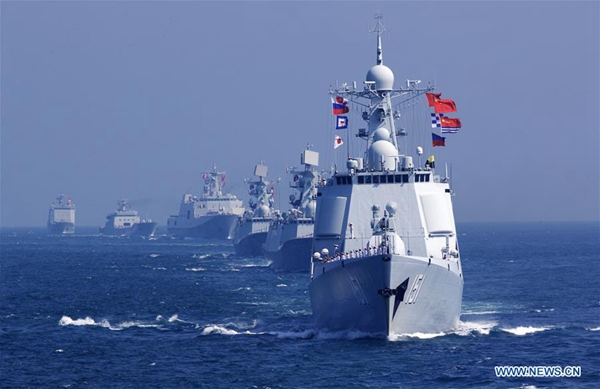Navy holds drills with Russia
 0 Comment(s)
0 Comment(s) Print
Print E-mail China Daily, July 24, 2017
E-mail China Daily, July 24, 2017
|
|
|
Chinese officers and soldiers waves to say goodbye to Russian fleet during a China-Russia naval joint drill at sea off south China's Guangdong Province, Sept. 19, 2016. (Xinhua File Photo/Zha Chunming) |
The Chinese ships arrived at the Russian seaport of Baltiysk on Friday. This year's exercise, dubbed Joint Sea 2017, will focus on strengthening Sino-Russia naval combat and coordination capabilities, as well as practicing maritime anti-piracy and emergency rescue operations.
These regular drills, which began in 2012 in the Yellow Sea, are not targeting against any other states, defense ministries from both countries said.
The first phase of the exercise is taking place in waters off the Russian cities of Kaliningrad and St. Petersburg from Monday to Friday. The second phase will be in the Russian Far East, the Sea of Japan and Okhotsk in September, according to the Russian defense ministry.
The drill is a practical step in strengthening the Sino-Russia comprehensive strategic partnership of coordination, as well as bolstering exchanges and cooperation between the two militaries, especially the navies, Vice-Admiral Tian Zhong, the deputy commander-in-chief of the People's Liberation Army Navy, said at the drill's opening ceremony on Saturday.
Russian Navy Deputy Commander-in-Chief Vice-Admiral Alexander Fedotenkov said the Joint Sea exercises have become more professional and comprehensive since 2012.
This year's exercise will feature China's most advanced military vessels, including the Type 052D guided missile destroyer Changsha, Type 054A guided missile frigate Yuncheng and the Type 903A supply ship Luomahu.
These ships belong to the South Sea Fleet responsible for operations in the South China Sea. They set off from their home port in Sanya, Hainan province, on June 18, and conducted live-fire drills in the Mediterranean on July 10 en route to the Baltic Sea, according to China's Defense Ministry.
The Russian Navy will deploy the latest class corvettes — Steregushchiy and Boiky. In addition, nearly a dozen aircraft and helicopters from both sides, such as Ka-27 helicopters and Su-24 fighter-bombers, will take part.
Since its debut, the annual Sino-Russian naval exercise has been closely monitored by the West. This year, British, Dutch and Danish ships trailed the Chinese flotilla as it passed into the Baltic Sea.
Li Xing, a professor of international relations at Beijing Normal University, said it is understandable for Western countries to closely follow this year's drill because this is the first time the Chinese navy is conducting exercises at NATO's doorstep.
Russia has also been moving its most powerful ships, including its nuclear-powered Kirov-class battle cruiser and the Typhoon-class ballistic missile submarine — the largest submarine ever built — into the Baltic Sea for the upcoming naval parade at St. Petersburg on July 30.
"The Chinese navy will learn much from this year's exercises, especially on improving far sea operations in unfamiliar waters. Such capabilities are crucial benchmarks for a strong navy, and the Chinese navy will have more in the future," he said.
The Chinese navy will learn much ... especially on improving far sea operation in -unfamiliar waters."







Go to Forum >>0 Comment(s)